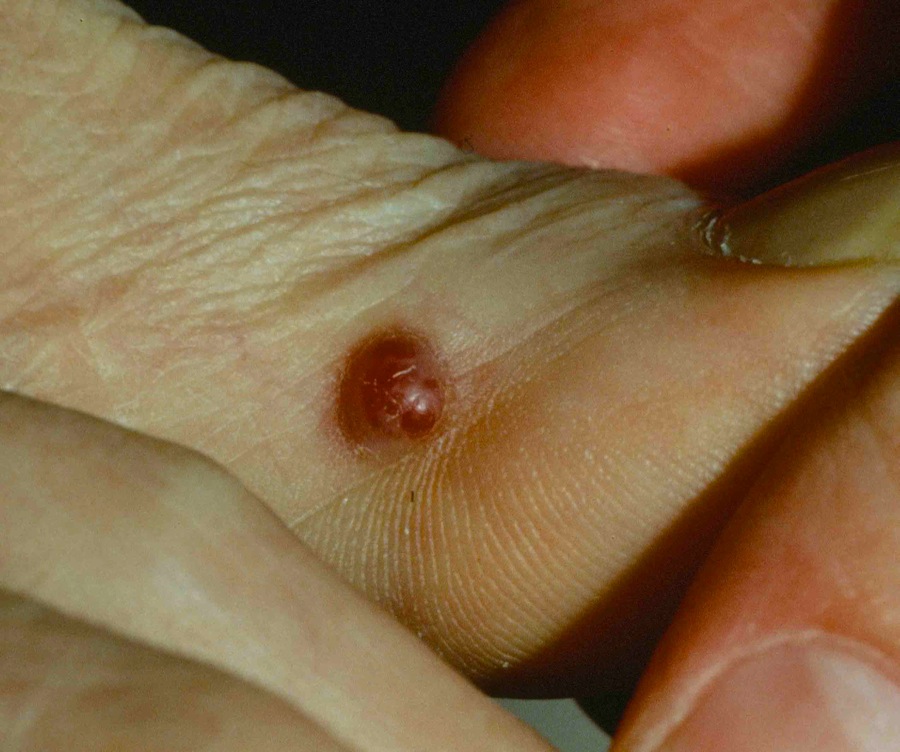
KAPOSI'S SARCOMA
Kaposi's sarcoma (KS) is a vascular proliferation of lymphatic endothelial cells that is related to infection by the human herpesvirus 8. Broadly speaking, there are two types of Kaposi's sarcoma (KS), the classic type, occurring in men of Southern or Eastern European descent and KS in immunocompromised patients, e.g., HIV, organ transplant.
- Multiple red-purple papules and nodules.
- Lower legs, feet, hard palate
- Lymphedema may complicated picture.
- Human herpesvirus 8 (HHV-8), a γ2-herpesvirus, also known as Kaposi's sarcoma-associated herpes virus (KSHV) is found in all forms of KS including HIV-associated KS, classic KS, and endemic KS, as well as a plasmablastic form of multicentric Castleman disease (KSHV-MCD), and primary effusion lymphoma.
- KS is the most frequent tumor associated with HIV infection. It relates closely with the immune status of the patient, namely T CD4 lymphocyte count, and is considered by WHO as an AIDS-defining disease.
- Since the introduction of HAART its incidence has declined significantly.
Pathogenesis
In 1994, the connection between KS and Human herpesvirus-8 (HHV-8) or Kaposi Sarcoma herpesvirus (KSHV) infection was established.
- HHV-8 is present in all forms of KS.
- Usually, there is impaired host immunity.
- HHV-8 is transmitted primarily via saliva in childhood.
- Seropositive family members will often infect other family members (endemic areas).
- It can be sexually transmitted; also rarely through blood transfusions/IV drug use.
- HHV-8 infects several different cells types including endothelial cells, B cells, epithelial cells, dendritic cells, monocytes and fibroblasts
- HHV-8 persists and proliferates through immune suppression and inflammation.
Classic KS usually presents as a reddish-blue to purple papulonodule or plaque beginning on the toe or sole. Progression is usually slow, but ultimately, almost any area of the body may be involved, especially the gastrointestinal tract.
HIV-related (and immunocompromised-related) KS usually presents as an asymptomatic, erythematous macule which later becomes raised and violaceous. Lesions are often ovoid following lines of cleavage. Lesions are common on the trunk, extremities, and oral cavity (where the palate is preferred). Koebnerization may occur.
HIV-negative KS does occur and is most common in men who have sex with men. Risk factors in this population include the number of years of sexual activity with men, older age, a higher number of sexual partners, a history of sexually transmitted disease and having sexual partner with KS.
How to Diagnose
Clinical appearance can be compelling, but biopsy is usually done (especially in the US).
RegionalDerm
Homepage | Who is Dr. White? | Privacy Policy | FAQs | Use of Images | Contact Dr. White
It is not the intention of RegionalDerm.com to provide specific medical advice, diagnosis or treatment. RegionalDerm.com only intends to provide users with information regarding various medical conditions for educational purposes and will not provide specific medical advice. Information on RegionalDerm.com is not intended as a substitute for seeking medical treatment and you should always seek the advice of a qualified healthcare provider for diagnosis and for answers to your individual questions. Information contained on RegionalDerm.com should never cause you to disregard professional medical advice or delay seeking treatment. If you live in the United States and believe you are having a medical emergency call 911 immediately.
